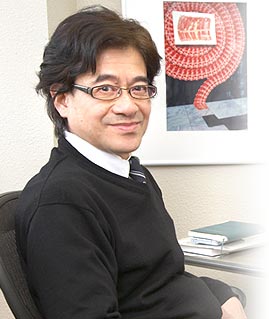

Faculty of Life Sciences, Professor
Immunology, M.D., Ph.D. Program Board member, Development of neutralizing antibody against HIV


 |
[Introduction]
The immune system is dependent largely on the acquired immunity against various exogenous pathogens and tumors existing or invading in the body. We have studied the molecular mechanism involved in activation of antigen specific B cells and in generation of high-affinity antibodies against T cell-dependent antigens (1, 2). The high-affinity antibodies produced after vaccination are particularly required for the defense from the viral infection. The eradication of virus is absolutely dependent on the success of designing the efficient vaccine to produce high-affinity antibodies against the virus. Nevertheless, the nature of virus often changes by the high-frequent mutation rate and escape from the first treatment with medicine and the antibodies generated in the patients. A major difficulty in the medical treatment and prevention of AIDS patient is associated with the hypermutation activity of HIV. |
[Purpose]
Aim of our study is to develop a new immunomanipulation technique
that may be applied for the prevention and hopefully for the therapy
of HIV infected patients.
[Background]
The production of high-affinity antibody is initiated by the activation-induced
cytidine deaminase (AID) that deaminates deoxycytidine
(dC) into deoxyuridine (dU) of immunoglobulin (Ig) V-region
genes. The attack of the single stranded Ig V-region DNA causes
further alteration of the adjacent sequence, generating somatic hypermutation
as a novel hypermutation mechanism by cytidine deamination followed
by the other components including uracil-DNA glycosylase(UNG) and
error prone DNA polymerases. In a screening of functional molecules
involved in generation of somatic hypermutation, we identified the
second molecule named germinal center-associated nuclear protein (GANP)
that augments generation of AID-induced somatic hypermutation
in Ig V-region gene during activation of antigen driven B
cells.
[Study plan]
In this gCOE group of AIDS research, we study two major subjects.
The first is regarding the molecular mechanism of GANP in regulation
of cytidine deamination of AID/Apobec family members. Apobec
members are recently known to be cytidine deaminase that deaminates
RNA strand or DNA strand of various target genes in the mammalian
cells. Recently, the infectivity and resistant activity of human cells
to HIV is thought to be dependent on the balance of APOBEC 3G of host
cells and Vif protein encoded by HIV genome. Apobec 3b is a cytidine
deaminase that mutates dC of single stranded DNA in human cells and
targets the HIV cDNA, causing the damage for the virus replication
in the host cells. Vif recruits a Cul5-containing E3 ubiquitin ligases
resulting in the polyubiqutination and destruction of APOBEC3G.
Therefore, the balance of both molecules may be critical for the clinical
course of HIV infection. GANP might play a role in the protection
of HIV infection in association with Apobec member protein. We would
like to focus on the study of regulation of Apobec member
protein particularly in the replication of HIV as collaboration
with Dr. Koito, a member of gCOE group.
Secondly, we apply the new biotechnology based on the GANP function
to prepare high-affinity monoclonal antibodies that can prevent
HIV infection. We have so far demonstrated that the GANP-transgenic
(GANPTg) mouse is a useful tool to establish extraordinarily
high-affinity monoclonal antibodies against the V3 epitope of HIV
(3). We have obtained the high-affinity monoclonal antibody that neutralize
HIV infection with KD = 1 x 10-11
M, which is extremely difficult to attain by the conventional method.
GANPTg mice with international
patent has been widely applied to establish the high-affinity antibodies
to many kinds of antigens including the virus spike proteins, cancer-specific
epitopes of surface membrane molecules, and the endogenous proteins.
Using this technology, we will establish the effective monoclonal
antibodies for the prevention of highly mutated HIV strains,
which will be certainly useful for the treatment of HIV patients.
[Expected results]
Establishment of efficient preventive tool (monoclonal antibody and
the associated chemical compounds) by GANPTg
mice |

♦Reference
|
|
1. |
Kuwahara K, Tomiyasu S, Fujimura S, Nomura K, Xing Y, Nishiyama N, Ogawa M, Imajoh-Ohmi S, Izuta S, Sakaguchi N. Germinal center-associated nuclear protein (GANP) has a phosphorylation-dependent DNA-primase activity that is up-regulated in germinal center regions. Proc Natl Acad Sci USA 2001;98:10279-83. |
|
2. |
Kuwahara K, Fujimura S, Takahashi Y, Nakagata N, Takemori T, Aizawa S, Sakaguchi N. Germinal center-associated nuclear protein contributes to affinity maturation of B cell antigen receptor in T cell-dependent responses. Proc Natl Acad Sci USA 2004;101:1010-5. |
|
3. |
Sakaguchi N, Kimura T, Matsushita S, Fujimura S, Shibata J, Araki M, Sakamoto T, Minoda C, Kuwahara K. Generation of high-affinity antibody against T cell-dependent antigen in the ganp gene-transgenic mouse. J Immunol 2005;174:4485-94. |

|







